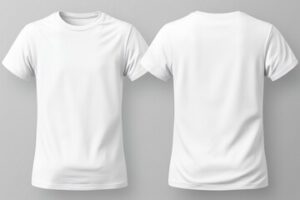The History of the T-Shirt
A t-shirt is an apparel staple that is deeply ingrained in world culture. This simple garment has transformed fashion and created its industry in garment decorating.
A shirt is a cloth garment that can be worn by both men and women for formal or casual occasions. Historically it was used as an undergarment and became a standalone outerwear garment in the mid-20th century.
If you’re looking for the perfect t-shirt, you have to think about more than just the size and color. You also have to consider the fabric, which is the base of the garment and will influence how it looks, feels and moves. The fabric of a t-shirt can also impact the price, how it prints and how it will hold up over time. There’s a lot of lingo in the apparel world that doesn’t make it into product descriptions, but understanding these terms will help you be an informed consumer.
The most common fabric for t-shirts is cotton. It’s a soft, natural material that has the ability to stretch. The quality of the cotton can vary, though, with ring-spun and organic cotton being some of the highest-quality options.
Another popular option for t-shirts is bamboo. It’s an eco-friendly, sustainable fabric that is more durable than cotton. It’s also antimicrobial, which means it will resist odors. However, it can be more expensive than other fabrics.
There are also a variety of different types of cotton and cotton blends. Some of the most popular are ring-spun and organic cotton, but you can also find premium cotton like Pima or mercerized cotton. These fabrics have a luxurious feel and will last longer than regular cotton t-shirts.
Blends of t-shirt fabric can have an impact on the price and the way the t-shirt fits. The most common is a 50% polyester/50% cotton blend. This blend has enough polyester to resist shrinking and clinging while still allowing the cotton to be soft and breathable. Some t-shirts are made with 65% polyester/35% cotton, which has slightly less polyester and more cotton for a softer blend that’s less prone to shrinking and clinging.
Another type of blend is rayon. This is a semi-synthetic fiber that’s made from regenerated cellulose sources such as wood pulp. Rayon has a silky, smooth feel and can be dyed a variety of colors. It’s often mixed with other fabrics for better durability and printing performance. It’s also used in blended t-shirt blends such as tri-blend and CVC.
Style
A t-shirt is one of the most versatile articles of clothing in any wardrobe. It can be worn for casual wear or to showcase a brand, organization, or cause. It can even be a fashion statement in its own right, as evidenced by the fact that Sharon Stone wore a ribbed knit tee to the Oscars in 1996. When designing a t-shirt, it is important to consider the fabric, fit, yarn count, and weight. This will help you to make the best choice of material and style for your product.
T-shirts come in a variety of different styles, including regular short-sleeved tees, long-sleeved tees, tank tops, and sweatshirts. They can be made of cotton or other lightweight fabrics, and they may or not feature a collar or sleeves. There are also a variety of knitting techniques that can be used to make t-shirts, such as jersey and rib knit. These are both stretchy and durable, and they can be adorned with various designs.
The fabric a t-shirt is made from can affect its overall feel and fit. The most common type of t-shirt is made from cotton, which is soft and breathable. However, it can become dingy and rough after repeated washings. It is also prone to shrinking and can wrinkle easily. To overcome these issues, manufacturers often use combed cotton, which is pretreated to produce a smoother and more durable fabric. This is more expensive, but it can provide a better finish.
Other types of t-shirts can be made from wool, silk, or synthetic materials such as polyester. They may have short or long sleeves, and they can be a solid color or decorated with graphics. T-shirts can also be embellished with rhinestones, embroidery, or other trims to add texture and dimension.
When it comes to the design of a t-shirt, it is essential to know your audience. This will help you to decide what kind of message or theme you want to convey with your shirt. Whether you are designing a t-shirt for a band, a company, or just for fun, it is essential that the design speaks to your audience in a way that will keep them interested over time.
Printing
Screen printing is a common way to print designs on t-shirts. It involves a stencil that acts as a template, a mesh screen, and a squeegee or blade to transfer the design to the shirts. This method is ideal for t-shirts with intricate or large designs. However, it’s important to remember that garbage in equals garbage out – the better the artwork you start with, the higher-quality screen prints you’ll get.
Another popular method of t-shirt printing is dye sublimation, which involves turning solid ink into a gas by applying heat and pressure. This process is ideal for synthetic fabrics like polyester, and it produces high-resolution, vibrant results. However, this technique isn’t suitable for cotton, which absorbs inks and results in bleeding or blurring.
Dye sublimation is a good choice for printing large-scale designs on t-shirts, but it’s not suitable for small orders or detailed artwork. The process also uses a lot of water and isn’t very eco-friendly, so it’s best for large businesses with a high demand for production.
Another option for t-shirt printing is digital direct-to-garment (DTG) printing. This method utilizes a special printer to produce the ink for the design on a transfer paper, which is then pressed against the shirt. It’s best for small-quantity production and is also more affordable than other methods.
This method also requires specialized inks, such as plastisol, which is more durable than traditional water-based inks. Plastisol ink is also available in a wider variety of colors, allowing for more creative designs. In addition, plastisol inks are less likely to crack or peel over time, making them ideal for high-quality t-shirt printing. Another t-shirt printing method is color discharge printing, which removes the original dye from the fabric and replaces it with a new one to create a negative image. This printing technique doesn’t work well with all fabrics, but it can be used to make unique vintage-looking t-shirts. The key to successful garment printing is ensuring that the ink is transferred evenly across the surface of the shirt, avoiding any areas with holes or streaks.
History
The t-shirt is so deeply embedded in our culture that it’s easy to forget that, relatively speaking, the garment is young. It’s also one of the most powerful marketing tools ever invented, a canvas upon which anyone can express themselves or promote their brand. The history of the t-shirt is one of innovation and evolution.
The first manufactured t-shirts came on the market in 1904 when the Cooper Underwear Company ran an ad for a “bachelor undershirt.” Although similar cotton tees were around well before this, it wasn’t until they started to appear in the Navy that the garment became firmly linked with military and heroic masculinity. After the end of World War II, this association was ratcheted up even further by the appearance of t-shirts in movies by Marlon Brando and James Dean. These stars promoted the t-shirt as outerwear to be proudly flaunted instead of innerwear to be hidden under other clothes. It wasn’t until the 1960s that women started to wear them as outerwear, too, but by this time they had become a unisex item of clothing.
Once this happened, t-shirts were suddenly not only a popular fashion trend but an effective medium for advertising. Whether it was Nike’s “Just Do It” slogan or a cute Hello Kitty image, businesses found that the t-shirt was a great way to reach potential customers and build brand recognition. Bands also seized on this new advertising opportunity by printing their artwork on t-shirts and selling them at concerts.
Today, the t-shirt is the most popular piece of clothing in the world. It is estimated that if all of the t-shirts in existence were lined up end to end, they would encircle the globe more than 230 times. With the ability to be printed with virtually anything, this versatile garment continues to evolve and change the way that we communicate.
